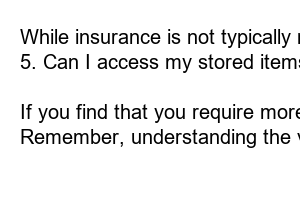이삿짐 보관비용
Moving Storage Costs: Everything You Need to Know
Are you planning a move soon? If so, one important factor to consider is the cost of moving storage. Whether you need short-term storage during your transition or long-term storage for your belongings, understanding the costs involved can help you plan your budget accordingly. In this blog post, we will break down the various factors that affect moving storage costs, so you can make an informed decision.
1. Location of the Storage Facility:
The location of the storage facility plays a significant role in determining the cost. **Storage facilities in prime areas or urban centers often have higher rates** compared to those in suburban or rural areas. This is due to high land and operational costs in expensive locations.
2. Storage Unit Size:
The size of the storage unit you choose will also impact the cost. **Larger units tend to have higher monthly rentals** compared to smaller ones. Before renting a storage unit, assess your needs and determine the appropriate size to avoid paying for more space than necessary.
3. Duration of Storage:
The length of time you require storage will affect the overall cost. **Short-term storage options are typically cheaper**, while long-term options may offer discounted rates. Consider how long you expect to need storage and discuss pricing options with the facility.
4. Additional Services:
Some storage facilities offer additional services such as climate control, 24/7 access, or insurance coverage for your belongings. **Opting for these extras may increase the overall cost** but can be worth the investment to protect your valuables or ensure convenient access to your stored items.
5. Accessibility and Convenience:
If you need frequent access to your storage unit or require additional conveniences such as loading docks or moving equipment, be prepared to pay extra. **Facilities with greater amenities or easy accessibility may have higher rates** due to the added benefits they provide.
6. Moving Season:
Similar to peak travel times, there are also peak seasons for moving. **During popular moving periods, such as summer or weekends**, the demand for storage units surges, which may cause prices to rise. If possible, consider scheduling your move during an off-peak season to secure better rates.
7. Negotiation and Research:
Don’t be afraid to negotiate or shop around for the best storage rates. **Do your research, compare quotes from different facilities**, and ask if they can match or beat competitors’ prices. Many storage providers are willing to negotiate to secure your business.
In summary, the cost of moving storage depends on various factors, including the location of the facility, the size of the storage unit, the duration of storage, additional services, accessibility, and the season. By understanding these factors and conducting diligent research, you can find a storage solution that fits both your needs and budget.
FAQs:
1. How much does moving storage typically cost?
Moving storage costs vary depending on the factors mentioned above. However, on average, you can expect to pay anywhere from $50 to $300 per month for a storage unit.
2. Are there any hidden costs to be aware of?
While most storage facilities are transparent about their pricing, it’s essential to ask about any additional fees or charges that may apply, such as security deposits, administration fees, or late payment penalties.
3. Can I reduce my storage costs?
Yes, you can reduce storage costs by carefully selecting the size of your unit, considering the duration of storage, and exploring discounts or promotions offered by the facility.
4. Is insurance necessary for my stored items?
While insurance is not typically required, it is highly recommended to protect your belongings in case of unexpected damage or loss. Check with your homeowner’s or renter’s insurance provider to see if they offer coverage for stored items or inquire about insurance options provided by the storage facility.
5. Can I access my stored items at any time?
Most storage facilities offer specific access hours during which you can enter your unit. However, some facilities provide 24/7 access for an additional fee.
6. What happens if I need more or less space than initially rented?
If you find that you require more or less space than initially rented, most storage facilities are flexible and can adjust your unit size accordingly. However, this may result in a change in pricing. Be sure to discuss any changes with the facility in advance.
Remember, understanding the various factors that impact moving storage costs will enable you to make an informed decision while staying within your budget. Happy moving and happy storing!

